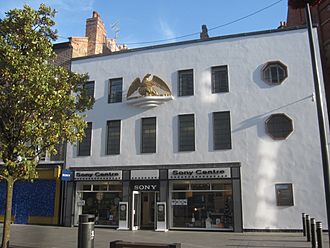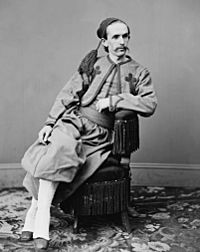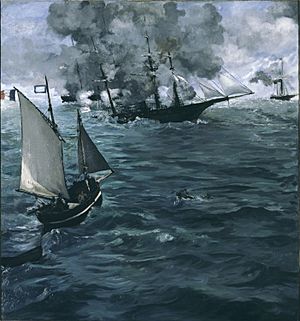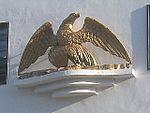Consulate of the United States, Liverpool facts for kids
Quick facts for kids Consulate of the United States in Liverpool |
|
|---|---|

former consulate building
|
|
| General information | |
| Address | Paradise Street |
| Town or city | Liverpool |
| Country | England |
| Coordinates | 53°24′14″N 2°59′10″W / 53.404°N 2.986°W |
| Inaugurated | 1790 |
The United States Consulate in Liverpool, England, was a special office. It was set up in 1790. This made it the very first overseas consulate opened by the new United States of America.
At that time, Liverpool was a super important port city. It was a major hub for trade across the Atlantic Ocean. It was a vital partner for the former Thirteen Colonies (which became the USA).
Many interesting people worked as consuls in Liverpool. These included the famous writer Nathaniel Hawthorne. Also, there was Thomas Haines Dudley, who was a spy. Another consul was John S. Service, who faced unfair accusations during a time called McCarthyism.
After World War II, Liverpool's importance as an international port slowly decreased. Because of this, the consulate eventually closed down. The American Consulate in Liverpool was on the third floor of the Cunard building. It permanently closed in 1975.
Contents
History of the US Consulate in Liverpool
The first consul was a man named James Maury. He held the job for a very long time, from 1790 to 1829. You can still see his portrait hanging in Liverpool Town Hall today.
In 1801, Maury helped start the American Chamber of Commerce in Liverpool. This group represented merchants from Liverpool who traded with the United States. Maury was the first person to sign the rules for this group. He also became its first President.
Maury was consul for 39 years. He stayed in the job until 1829. Then, President Andrew Jackson removed him from office.
The consulate building was located right by the water. It was near Steers Dock and the Pool of Liverpool. The building had a golden bald eagle on it. This is the national symbol of the United States. It was a comforting sign for American sailors or travelers arriving in Liverpool.
In those days, United States Consuls did not get a regular salary. They earned money from fees for their services. Their main job was to check that trade between the US and other countries was legal. They also helped American sailors who were stranded or in trouble.
Nathaniel Hawthorne: A Famous Consul

One of the most famous consuls was the writer Nathaniel Hawthorne. He was appointed by President Franklin Pierce in 1853. This happened shortly after he published his book, Tanglewood Tales.
Being the consul in Liverpool was considered a very good job. It was said to be the second most important foreign service position after the Embassy in London. However, living in Liverpool was expensive. Hawthorne even wrote to the Secretary of State. He said he wasn't paid enough. He asked for more money to cover his living costs. He explained that a consul with a family needed more money to live well in such a big city.
In 1855, Congress passed a law. It set the consul's salary in Liverpool at $7,500 per year.
Hawthorne wrote in his journal about the American sailors he met. He found his duties as consul to be quite challenging. His job took him to many different places. He visited prisons, police-courts, hospitals, and even places for people with mental health issues. He met all sorts of people, from officials to those who were struggling.
Hawthorne left the position in 1857. He was known for doing his job carefully and effectively.
The American Civil War and Liverpool

During the American Civil War (1861–1865), consul Thomas Haines Dudley worked hard. He tried to stop ships from Liverpool from helping the Confederate ports. Great Britain officially stayed neutral during the war. However, many people in Liverpool supported the Confederacy.
One famous ship was the CSS Alabama. This warship was built for the Confederate Navy in Birkenhead, near Liverpool, in 1862. It was later sunk by a Union ship, the USS Kearsarge, in 1864. Some British merchants in Liverpool also helped the Confederacy. They sent supplies and luxury goods through the Union blockade. In return, they received cotton and tobacco.
In 1865, President Abraham Lincoln was assassinated. A conspirator named John Surratt fled to Europe. He hid in Liverpool for a short time. He then went to the Vatican City and joined a military group there.
Consul Dudley wanted to retire after the war. But he knew a lot about Confederate money and ships in Liverpool. So, he stayed on as consul. He helped seize Confederate ships and return the money to the United States government. Relations between Britain and the United States were strained after the war. This was partly because of Liverpool's role in helping the Confederacy. These issues were finally settled in 1871 with the Treaty of Washington.
The 20th Century and Closure
After World War II, Liverpool became less important for trade with the United States. Because of this, the consulate eventually closed. Some of the last consuls included George H. Steuart and John S. Service. John S. Service had faced unfair accusations of communist sympathies. These accusations came from Senator Joseph McCarthy.
Eventually, the consulate building was no longer used. For a while, it even became a pub called The Eagle.
Restoring the Historic Building and Eagle
Today, James Maury's old office is in the middle of Liverpool's newest shopping center, Liverpool One. The building used to be empty and run down. It was the first building bought by The Grosvenor Group. This was part of a big plan to redevelop Liverpool's city center. This project was called "The Paradise Street Project".
The building and the eagle that decorated it were restored in 2008. The building has since been turned into shops and apartments. It has housed The Liverpool Sony Centre and three luxury apartments. Since December 2014, it has been home to a branch of Cote Bistro.
The bald eagle on the building today might be the original one. The original eagle was likely brought from the United States. It was probably carved by shipwrights. These were skilled workers who carved parts of ships.
In 2008, what was left of the 200 kg (about 440 lb) eagle was removed for repair. It was taken to the National Conservation Centre for cleaning and restoration. The sculpture was in very bad condition. It had to be dried out for several months. Then, a new head was carved for it, based on old photos. New wing tips and a new base were also added.
The restored eagle was put back on the building in October 2008. There was a small ceremony for it. David Whitty, who oversaw the restoration, said the eagle "should be good for another 200 years."
Notable Consuls of the United States in Liverpool
Here are some of the important people who served as consuls in Liverpool:
- 1790–1829 James Maury
- 1853–1857 Nathaniel Hawthorne
- 1861–1872 Thomas Haines Dudley
- 1878–1885 Stephen B. Packard
- 1959–1962 John S. Service



